Homemade Apple Cider Vinegar
There’s just something about making something out of nothing. That was a mouthful. But you get the idea. There’s a magic in turning food scraps into something useful . And this apple cider vinegar recipe is a staple you’ll use all the time in tons of recipes.
Apple Cider Vinegar
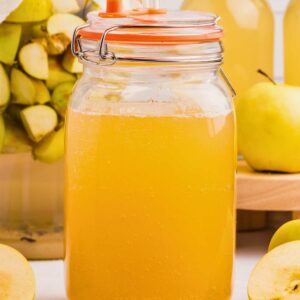
Equipment
- Large container (gallon-sized and preferably glass)
- Cheesecloth
- String or rubber band
- Wooden spoon
- Canning weight
- fine mesh strainer
- Jar with a fermenting attachment
Ingredients
- 8 cups apple cores and peels or cut-up apples
- ½ cup granulated sugar
- 8 cups water filtered, warm
Save This Recipe
You'll join my email list which you will love. And if you don't, unsubscribe in one click. ❤️
Instructions
- Fill a jar with apples. Wash a large gallon-sized jar with hot, soapy water. Add enough apple scraps to fill the jar halfway (about 8 cups when using a gallon-sized container).
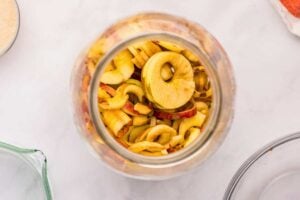
- Add water. Fill the jar with about 8 cups of warm (not hot) filtered water, leaving about 1 ½ inches of headspace.

- Add sugar. Add the sugar and stir well. You will ultimately want 1 tablespoon of sugar per cup of water.

- Cover and sit overnight. Cover the mouth of the jar with a piece of cheesecloth and seal with a string or rubber band. Allow the mixture to sit overnight at room temperature.

- Add canning weight. The next day, stir the apple mixture. Place a canning/fermenting weight on top (this pushes down the apple scraps to keep them in the water and helps prevent mold from growing). If you don’t have a canning weight, you can use a sandwich bag filled halfway with water to use as a weight.

- Store. Store the mixture at room temperature in a cool, dark place, stirring 1-2 times daily. After 2-4 weeks, you should notice the apple scraps starting to sink to the bottom. This is when it is time to strain the mixture.

- Strain. Place a fine mesh strainer over a bowl and pour the mixture into the strainer, removing the apple scraps.

- Ferment and store. Transfer the liquid to a jar with a fermenting attachment and allow the mixture to sit until bubbles stop forming. You will want to “burp” the mixture every other day by loosening the lid, allowing the gasses to escape, and quickly tightening again, limiting exposure to new oxygen. Once the bubbles are gone and the liquid has a distinct vinegar smell, you can transfer the liquid to a jar for long-term storage.

Notes
Did You Make This?
I would love it if you would leave a review!I started making my own vinegar after I realized how many apple scraps I was throwing away.

Now, I keep all my scraps until I have enough to make this recipe. With all the fall baking I do, it doesn’t take long.
A Newsletter you’ll love
Daily recipes from the farmhouse, Sunday meal plans, seasonal ideas, straight from my kitchen to your inbox.
I promise to keep your email address safe. Unsubscribe at any time
Tips for Success
Watch for tiny bubbles rising to the surface. If you don’t see any after a week, you might need to put it in a warmer spot or give it more air.
Make sure your vinegar smells sharp and clean – never musty or “off.”
Keep your apple scraps under the water. They can grow mold and spoil the batch if they get above the water.
Stir gently. You’re trying to add oxygen without disturbing the bacteria.
Ingredients and Equipment
Apples: You can use scraps or whole apple pieces. Sweet ones have more sugar for fermentation, and tart ones add to more the flavor.
Sugar: Plain granulated sugar works best. You need the sugar: it’s not for sweetness; it’s for the fermentation.

Glass container: This is essential! Metal will react with the acid, and plastic can leach chemicals.
Fermentation weight: Keeps the apple pieces submerged.
Heart’s Content Farmhouse is a participant in the Amazon Services LLC Associates Program, an affiliate advertising program designed to provide a means for sites to earn advertising fees by advertising and linking to Amazon.com. This means that when you click on certain links on this site and make a purchase, I may earn a small commission at no additional cost to you. I only recommend products I genuinely believe in and would use in my own kitchen. As an Amazon Associate, I earn from qualifying purchases.
4-Pack of Fermentation Glass Weights with Easy Grip Handle for Wide Mouth Mason JarsBundle of 2 Apple Picking Vintage Themed Kitchen Towels, Tea Towel and Tie Towel
2 Pack 1 Gallon Large Fermentation Jars with 3 Airlocks and 2 SCREW Lids(100% Airtight Heavy Duty Lid w Silicone) – Wide Mouth Glass Jars w Scale Mark – Pickle Jars for Sauerkraut, Sourdough Starter
Cheese Cloths 100 Grade, 45X40 Inches-12 Sq Feet Unbleached 100% Organic Cotton Fabric – 1.4 Sq Yards – Reusable Ultra Fine Mesh Muslin Cloth – Cheesecloth For Straining Cooking Baking, Cheese Making
DII Farmhouse Chicken Wire Storage Baskets with Liner, Small, Rustic Natural, 9x7x6
Mini Ceramic Spoon Rest Apple Kitchen Décor Teaspoon Tea Bag Rest (5 Pack)
Make It Your Own
- Try adding pears instead of (or mixed with) apples for a different flavor
- Add a splash of raw ACV from a previous batch to help start fermentation
I know watching a jar of apple scraps over weeks is not as exciting as pulling fresh cookies from the oven, but the end result is worth it to have this useful pantry staple.

Love,


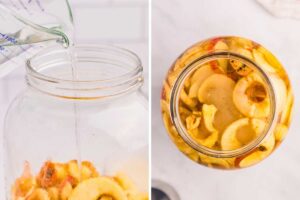
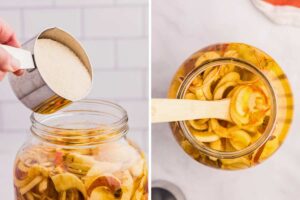
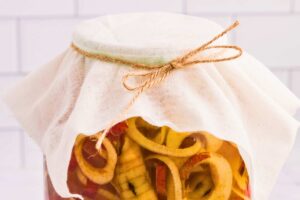
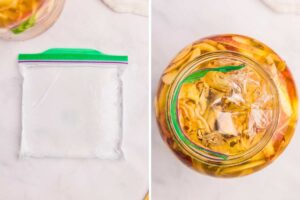
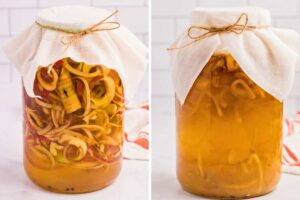
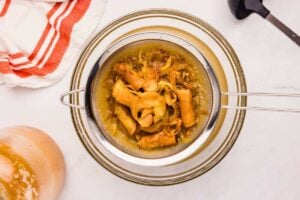
















Home made vinegar isn’t to be used for pickling as the acidity level isn’t measured. Pickling vinegars are 5%. How do you measure home made acidity?
hi Dianna, I wouldn’t recommend using it for canning (although these is a very complicated process to measure it’s acidity) unless you want to test the ph of your final canned item using PH strips. HOWEVER, I do use this in refrigerator pickle recipes.
I live this! Thank you!
I use ACV every morning as a facial toner and am excited to make my own!
Hey Morticia, thank you so much! I’m so glad you enjoyed it. I hope you have fun making your own. Let me know how it turns out or if you have any questions along the way!